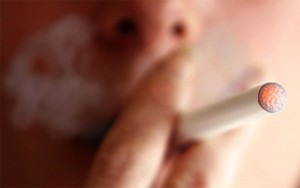Electronic Smokes: Healthy or Dangerous?
By Kiera McCaffrey
 With most Texas cities banning smoking in workplaces, restaurants, bars or all three, some smokers are getting their nicotine fixes in a 21st-century way: electronically. Electronic cigarettes hit the national market a year ago to little fanfare. But the devices, the size and shape of traditional cigarettes, have developed a following among office workers and others who can’t always light up when they want a nicotine kick.
With most Texas cities banning smoking in workplaces, restaurants, bars or all three, some smokers are getting their nicotine fixes in a 21st-century way: electronically. Electronic cigarettes hit the national market a year ago to little fanfare. But the devices, the size and shape of traditional cigarettes, have developed a following among office workers and others who can’t always light up when they want a nicotine kick.
Marketers also claim the product is a healthier alternative to smoking, chewing tobacco or using snuff, because e-cigarettes contain no tobacco, tar or chemicals. That appeals to some smokers who want to quit but don’t want to suffer from nicotine withdrawal.
Russell Cawyer, a Houston lawyer who publishes the Texas Employment Law Update, an online resource for employers, said workplace-smoking bans do not extend to the cigarette’s electronic cousin.
 “There are still no reported cases to see how the courts are treating the use of these e-cigarettes at work,” Cawyer said. “So employers remain free to prohibit or permit them in the workplace.” Cawyer said his review of the e-cigarettes leads him to believe their use in the workplace is not harmful to others. “You have none of those secondary effects that you have with tobacco,” he said. “You don’t have tar, you don’t have smoke, you don’t have smell. It just is a water vapor.”
“There are still no reported cases to see how the courts are treating the use of these e-cigarettes at work,” Cawyer said. “So employers remain free to prohibit or permit them in the workplace.” Cawyer said his review of the e-cigarettes leads him to believe their use in the workplace is not harmful to others. “You have none of those secondary effects that you have with tobacco,” he said. “You don’t have tar, you don’t have smoke, you don’t have smell. It just is a water vapor.”
E-cigarettes are metals tubes loaded with nicotine. An atomizer on one end (where a cigarette filter would be) steams the nicotine and releases a puff of white vapor that looks like smoke but is almost odorless. The other end of the device lights up red when the user takes a drag. “For smokers, it’s not like a toy,” said Tim Cornwell, an e-cig distributor. “It’s actual tobacco flavor, an extract from the plant. It’s just straight, raw nicotine.”
Unlike the nicotine patch popular with smokers trying to quit, the e-cigarette mimics the act of taking a puff. This attracts some smokers who want to drop the cigarettes but enjoy the process of smoking. Jesse Camacho is a 54-year-old former smoker in Corpus Christi who hopes someday to kick nicotine forever. He said he prefers the gadgets to other nicotine products and ordered his e-cigarettes online after he saw them for sale in a mall and did some research. “I had been trying to quit cigarettes for a long time and was intrigued by claims made from electronic cigarettes,” he said, noting that he has tried alternatives to cigarettes in the past but did not like them. “Cigars were too strong, and chewing tobacco almost made me throw up.”
Camacho said he feels better physically since replacing his tobacco cigarettes with their electronic cousins.
While some smokers praise the product as similar to real cigarettes in taste and effect, not everyone is happy about it. The Food and Drug Administration says e-cigarettes may not be a healthy alternative to a pack of smokes. Unlike other nicotine products, which are often used as smoking-cessation methods, e-cigarettes haven’t been studied closely.
Australia, Brazil, Canada, Israel, Mexico, and New Zealand have banned e-cigarettes, and they are restricted in Finland, Malaysia, and Singapore. New Jersey has already banned them, and New York and Illinois had similar bills working through their legislatures as of April 2010. The FDA wants to regulate them nationwide, and if it gets its way, the product could be taxed, restricted or even pulled from the market. But for now, fans are free to puff away.
Retailers also pitch e-cigarettes to smokers who don’t want to leave their butts behind at the office door. Tim Cornwell and a partner opened a Smoking Everywhere kiosk in Barton Creek Mall in Austin last year. Business has been steady, he said. While he touts the e-cigarettes for delivering a nicotine hit with “no secondhand smoke, no smell, no bad breath, no yellow teeth,” he also says customers love that they can smoke almost everywhere.
But the FDA says it’s too soon to tell whether the e-cigarettes are dangerous. “The big question about these is because they haven’t been reviewed by the FDA,” said Siobhan DeLancey, a spokeswoman for the agency. “We don’t know what the long-term effects may be.”
For now, a small group of devoted nonsmokers is enjoying the privilege of puffing indoors. “I ‘vape’ discreetly” at work, Camacho said, using the verb shortened from “vapor” that many e-cig fans prefer. Others aren’t so discreet. “I’ve had people tell me they’ve smoked it on an airplane,” said Cornwell, the kiosk owner. “I myself tried it on an airplane and it did not work too well for me.” After a fellow passenger complained, Cornwell said, the flight attendant asked him to not to use the e-cigarette at his seat anymore but suggested he could use it in the bathroom.
He doesn’t pitch his product as airplane-friendly but doesn’t regret the slight excitement he caused. “I had to try it,” Cornwell said, laughing.